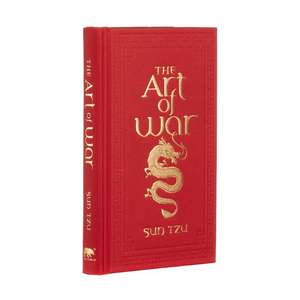The Art of War
Autor Sun Tzu Traducere de Lionel Gilesen Limba Engleză Hardback – 20 aug 2020
Preț: 73.40 lei
Nou
14.05€ • 15.27$ • 11.81£
Carte disponibilă
Livrare economică 31 martie-14 aprilie
Specificații
ISBN-10: 1838576371
Pagini: 208
Dimensiuni: 110 x 171 x 19 mm
Greutate: 0.26 kg
Editura: Arcturus Publishing
Descriere
The Art of War is the collection of leadership and military strategies composed by the esteemed Chinese general, Sun Tzu. Divided into 13 distinct chapters, each category gives clarity and voice to varying subjects pertaining to the intricacies of war and wartime strategy.
Having inspired generations of readers,The Art of War continues to be perceived as a kind of spiritual lighthouse for all those seeking sage leadership advice. Though Sun Tzu's expertise was considered to be professing wartime strategy, the principals enumerated within the text extend far beyond the logistics of a battlefield. Having lived during the Warring States Period, Sun Tzu understood conflict and political strife.
Sun Tzu, using the culmination of decades worth of knowledge inspired generations of leaders with his words. His insight was not wasted on the bloodshed of lives lost in battle, yet it was composed into beautifully succinct proverbs and adages that make up the whole of The Art of War. Perhaps his most well-known axiom is, “Know the enemy and know yourself, and you can fight a hundred battles with no danger of defeat.”
With proverbs as popular as the one above, the entirety of his work is composed of this level of insight. As pertinent as it was when it was written over 2,000 year ago, The Art of War is a true work of philosophical mastery. With eye-catching new covers and a professionally typeset manuscript, this edition of The Art of War is both modern and readable.
Notă biografică
Sun Tzu was a Chinese general, military strategist, writer and philosopher who lived in the Eastern Zhou period of ancient China. Sun Tzu is traditionally credited as the author of The Art of War, an influential work of military strategy that has affected both Western and East Asian philosophy and military thinking. His works focus much more on alternatives to battle, such as stratagem, delay, the use of spies and alternatives to war itself, the making and keeping of alliances, the uses of deceit and a willingness to submit, at least temporarily, to more powerful foes.[3] Sun Tzu is revered in Chinese and East Asian culture as a legendary historical and military figure. His birth name was Sun Wu (Chinese: ¿¿) and he was known outside of his family by his courtesy name Changqing (Chinese: ¿¿ The name Sun Tzu by which he is best known in the Western World is an honorific which means "Master Sun".
Sun Tzu's historicity is uncertain. The Han dynasty historian Sima Qian and other traditional Chinese historians placed him as a minister to King Helü of Wu and dated his lifetime to 544-496 BC. Modern scholars accepting his historicity place the extant text of The Art of War in the later Warring States period based on its style of composition and its descriptions of warfare.[4] Traditional accounts state that the general's descendant Sun Bin wrote a treatise on military tactics, also titled The Art of War. Since Sun Wu and Sun Bin were referred to as Sun Tzu in classical Chinese texts, some historians believed them identical, prior to the rediscovery of Sun Bin's treatise in 1972.
Sun Tzu's work has been praised and employed in East Asian warfare since its composition. During the twentieth century, The Art of War grew in popularity and saw practical use in Western society as well. It continues to influence many competitive endeavors in the world, including culture, politics, business and sports, as well as modern warfare.
Recenzii
"What the ancients called a clever fighter is one who not only wins, but excels at winning with ease."
"If you know the enemy and know yourself, you need not fear the result of a hundred battles. If you know yourself but not the enemy, for every victory gained you will also suffer a defeat."
"If words of command are not clear and distinct, if orders are not thoroughly understood, then the general is to blame."
Cuprins
Foreword by Marc Benioff ix
Preface by Thomas Cleary xv
Introduction xxiii
A Note on the Translation xxxvii
1. Calculations 3
2. Doing Battle 17
3. Planning Attacks 29
4. Formation 47
5. Force 57
6. Weakness and Strength 67
7. Armed Struggle 83
8. Nine Changes 99
9. Army Maneuvers 111
10. Ground Formation 131
11. Nine Grounds 149
12. Fire Attacks 179
13. Using Spies 189
Acknowledgments 201
Notes 205
Suggestions for Further Reading 209

























